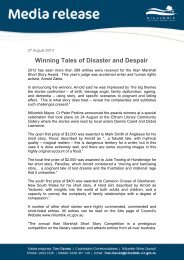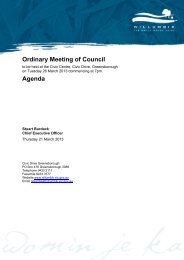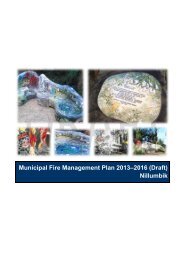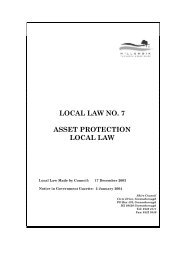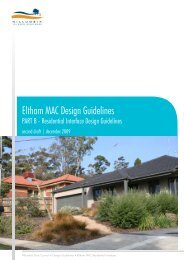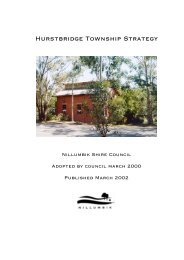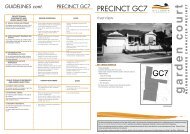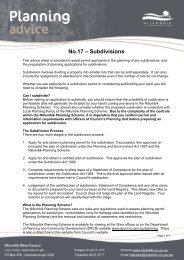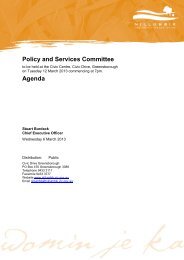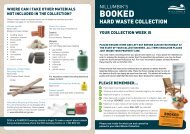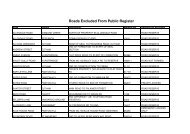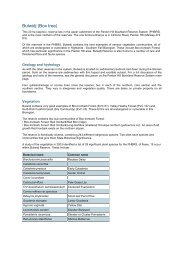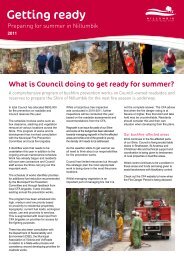Sustainable Water Management Plan - Nillumbik Shire Council
Sustainable Water Management Plan - Nillumbik Shire Council
Sustainable Water Management Plan - Nillumbik Shire Council
Create successful ePaper yourself
Turn your PDF publications into a flip-book with our unique Google optimized e-Paper software.
Good stormwater quality is important as waterways<br />
are integral to <strong>Nillumbik</strong>’s character, flora and faunal<br />
biodiversity, as well as playing an important role in<br />
influencing the wellbeing of the local community.<br />
Many people use and enjoy the areas of open space<br />
along waterways for various recreational activities,<br />
and the degradation of these areas may ultimately<br />
affect the quality of life enjoyed by the community.<br />
Erosion and sediment control<br />
Sediment in waterways can impact on plant growth<br />
as well as the health of aquatic and fauna species<br />
reliant on these water sources for habitat. Particles<br />
of soil and silt can line the banks of waterways<br />
smothering stream and riparian vegetation, while<br />
heavy loads may also reduce the amount of oxygen<br />
available to support aquatic life.<br />
In addition to being important for social wellbeing,<br />
stormwater is also a resource that can bring<br />
environmental and economic benefits. Rather<br />
than contributing to pollution, it can be captured,<br />
treated and reused, becoming a major contributor<br />
to our water supply. ‘Stormwater runoff from cities<br />
is almost equal to the amount of potable imported<br />
water that is used. More than 50% of high quality<br />
drinking water piped to urban areas is used for<br />
lower quality purposes such as gardening and<br />
toilet flushing.’ Therefore there is great potential<br />
to expand the reuse of stormwater for non-drinking<br />
purposes. Conserving stormwater will also reduce<br />
the level of pollutants reaching our local waterways.<br />
Current water quality issues in <strong>Nillumbik</strong><br />
As part of Milestone 1 of the ICLEI <strong>Water</strong> Campaign,<br />
<strong>Council</strong> undertook an inventory of water quality<br />
within the municipality. This, in conjunction with a<br />
review of the SMP and DWMP, highlighted some<br />
gaps in the strategic management of <strong>Council</strong>’s<br />
operations and responsibilities, which may negatively<br />
impact on water quality. In particular, it identified<br />
the three functions of <strong>Council</strong> which may have an<br />
impact on water quality. These are erosion and<br />
sediment pollution, wastewater treatment as well as<br />
swimming pool management. Within the community<br />
sector, activities also included erosion and sediment<br />
pollution and wastewater treatment plus high levels<br />
of nutrients and toxic pollutants. While not identified<br />
as a major threat at present, gross litter levels<br />
resulting from an increase in residential, industrial<br />
and commercial development in the <strong>Shire</strong> should<br />
also be considered as a management issue.<br />
The <strong>Shire</strong> consists largely of rural and low density<br />
residential zones with a number of small townships.<br />
A large number of roads in these areas are unsealed<br />
(dirt or gravel) and require regular regrading. Due to<br />
the highly dispersive clay profiles during heavy rain<br />
events, sediment from these roads can be washed<br />
into stormwater drains and directed into local<br />
waterways.<br />
Although there is a minimal amount of development<br />
occurring within the <strong>Shire</strong>, construction site run-off<br />
(often a result of poor site management practices)<br />
can lead to high levels of sediment and potentially<br />
toxic materials being washed into local waterways.<br />
Increasing urban development contributes to an<br />
increase in stormwater run-off from impervious<br />
surfaces that would have previously been absorbed<br />
into the soil. In heavy rain, this results in higher<br />
stream flows which can cause erosion of stream<br />
banks resulting in loss of riparian habitat and<br />
increased sediment pollution.<br />
In some rural and low density residential areas, tree<br />
and vegetation cover has been removed or degraded<br />
due to poor stock management and land clearing<br />
leaving creek and gully banks vulnerable to erosion.<br />
Large infestations of rabbits and weeds are also<br />
contributing to decreased bank stability and erosion<br />
problems.<br />
Wastewater treatment<br />
It has been highlighted in both the SMP and DWMP<br />
that there is a high risk to public health and the<br />
environment from the use of domestic wastewater<br />
treatment (or septic) systems in the <strong>Shire</strong>. A large<br />
number of these systems, particularly those in<br />
residential areas, are failing to deliver satisfactory<br />
performance due to inappropriate system design<br />
and/or management. While the management of<br />
septics is the responsibility of the property owner or<br />
resident, <strong>Council</strong> is responsible for ensuring these<br />
systems do not cause a risk to public health or<br />
the environment. <strong>Council</strong> is required to ensure the<br />
appropriate selection and installation of septics on<br />
private property and to monitor the compliance of<br />
satisfactory system performance.<br />
There is a large number of properties within the<br />
<strong>Shire</strong> that currently discharge greywater off-site, a<br />
consequence of previous environmental legislation<br />
standards when it was assumed that properties<br />
would be provided with reticulated sewerage<br />
services within a short time frame. While many of<br />
these properties are in areas currently listed on<br />
the Yarra Valley <strong>Water</strong> sewerage backlog program,<br />
at the time of this report timelines for sewerage<br />
installation in these areas is still unknown and<br />
uncertain. Some of these properties are in urban<br />
parts of the <strong>Shire</strong>, but the true extent of the problem<br />
is not fully known.<br />
Many of the existing domestic wastewater treatment<br />
systems throughout the <strong>Shire</strong> are not being<br />
managed or maintained correctly. A survey of<br />
residents undertaken by <strong>Council</strong>’s Public Health Unit<br />
in 2005 identified that approximately 20% of systems<br />
did not have the required servicing undertaken in<br />
the appropriate timeframe. Surveys, discussions<br />
with committees and property inspections have<br />
identified that many property owners are unclear<br />
of the requirements of septic system management<br />
and, in some cases residents, are unaware that their<br />
property is actually connected to a septic system.<br />
The supply of reticulated water to properties which<br />
are currently serviced by septics is also contributing<br />
to septic management problems. When households<br />
rely solely on rainwater, there is often a much<br />
greater consciousness to reduce water usage. When<br />
connected to reticulated water, limitations of water<br />
use are not an obvious issue and occupants can be<br />
less conscientious with water conservation. High<br />
water use levels in the home can create pressures<br />
on septic systems which are not designed to treat<br />
large volumes of water.<br />
Badly designed stormwater disposal systems<br />
on properties in unsewered areas can affect the<br />
placement of septic systems when developing new<br />
properties. An integrated approach that considers<br />
both stormwater and domestic wastewater treatment<br />
and disposal needs to be undertaken when issuing<br />
planning permits.<br />
30 <strong>Sustainable</strong> <strong>Water</strong> <strong>Management</strong> <strong>Plan</strong> <strong>Sustainable</strong> <strong>Water</strong> <strong>Management</strong> <strong>Plan</strong>



